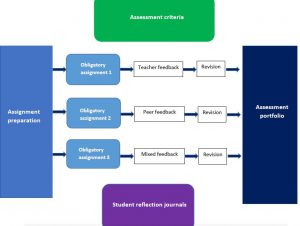Assessment Reform Group. (2002). Researched-based principles of assessment for learning to guide classroom practice. Retrieved from http://www.nuffieldfoundation.org/assessment-reform-group
Bader, M., Burner, T., Iversen, S. H. & Varga, Z. (2019). Student perspectives on formative feedback as part of writing portfolios. Assessment & Evaluation in Higher Education. DOI: 10.1080/02602938.2018.1564811
Black, P., & Wiliam, D. (1998). Assessment and classroom learning. Assessment in Education: Principles, Policy & Practice, 5(1), 7-74.
Black, P., & Wiliam, D. (2009). Developing the theory of formative assessment. Educational Assessment, Evaluation and Accountability, 21(1), 5-31.
Black, P., Harrison, C., Lee, C., Marshall, B., & Wiliam, D. (2003). Assessment for learning. Putting it into practice. Maidenhead, Berkshire: Open University Press.
Burner, T. (2014). The potential formative benefits of portfolio assessment in second and foreign language writing contexts: A review of the literature. Studies in Educational Evaluation, 43(4), 139-149.
Hattie, J. (2012). Visible learning for teachers: Maximizing impact on learning. New York: Routledge.
Klenowski, V. (2002). Developing portfolios for learning and assessment. Processes and principles. London: Routledge Falmer.
Wiliam, D. (2011). What is assessment for learning? Studies in Educational Evaluation, 37(1), 3-14.

